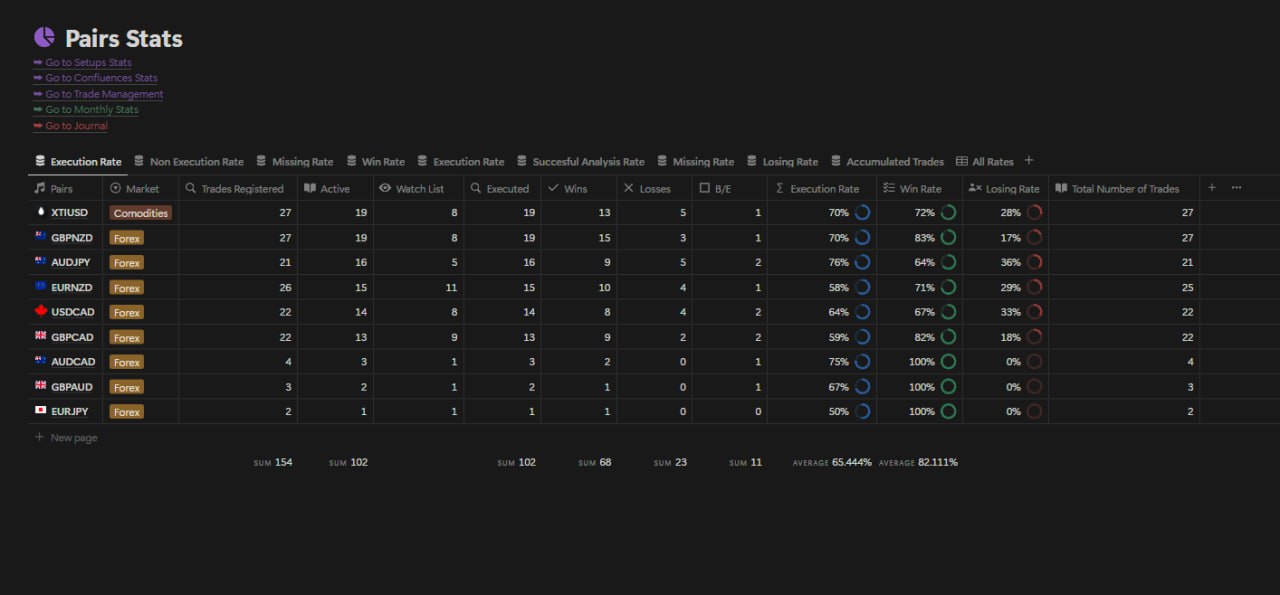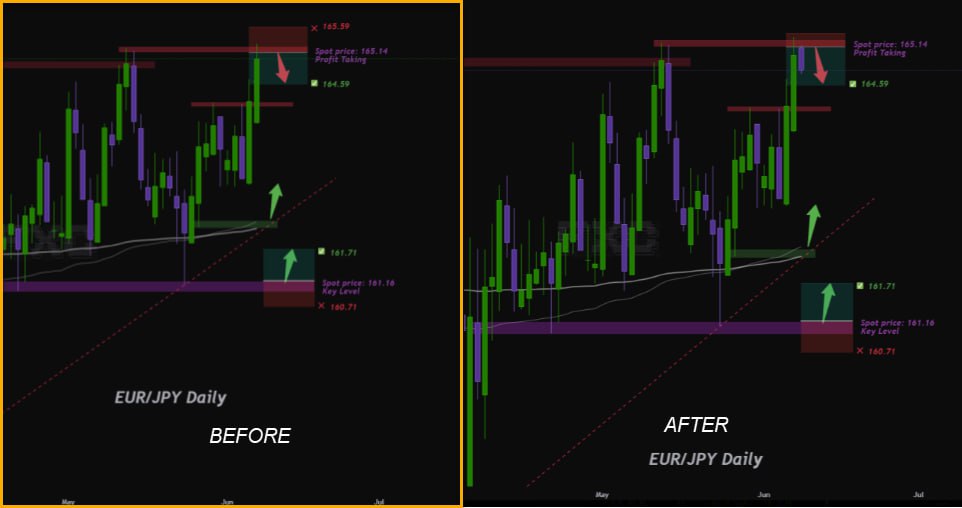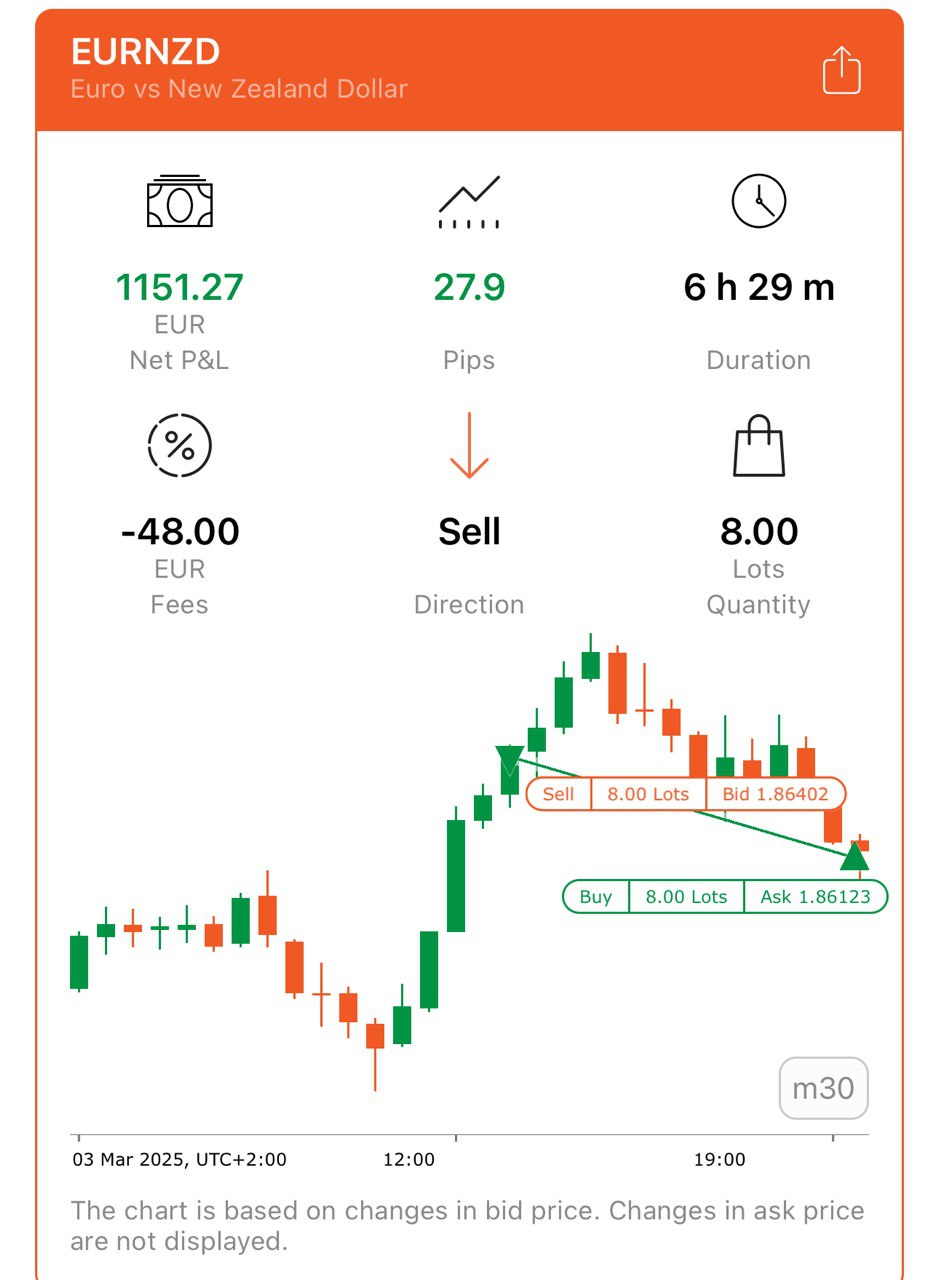10R Week at FXC
June might have started slow here at FXC, but it only took one powerful week in our Silver Membership to demonstrate why proven strategies and disciplined execution consistently outperform guesswork.
Wednesday: Another Clean Oil Win
Many traders assume FXC is all about forex and gold. The reality is, we cover much more.
Dan, our in-house oil specialist, delivered a precise win on XTIUSD:
-
Main target reached at 64.33
-
Trade management and rationale shared in advance
-
A full video update followed, breaking down the trade and outlining the next setups, available exclusively to Silver and Gold Members
If you have been overlooking commodities, this was the reminder that high-opportunity markets like oil and metals can be an essential part of your trading edge.
Thursday: 110 Pips Before Breakfast
Thursday morning was a clear example of strategy in action:
-
Members used insights from our Fundamental Course to short GBP after the negative GDP release.
-
Our AI strategy triggered a clean GN sell for Gold Members.
-
Analyst Dan shared an EN sell setup for Silver Members that also reached target.
110 pips secured before most traders had even finished charting their day.
This is not luck. It’s the result of structured analysis, timing, and decisive execution that our members have access to every day.
If you are not part of the Silver Membership, consider this:
-
How many wins have you locked in this week?
-
Are you leaving profits on the table by trading alone?
The truth is simple: This membership can pay for itself – if you put it to work.
Ready to see what consistent trading results look like?
If you’re wondering which membership suits you best, this blog post will guide you through all the options so you can choose the right level of support, tools, and analysis for your goals.
Silver Membership Performance Update
Real-Time Trade Ideas from a Verified Trader
What if you could follow the exact thought process of a consistently verified trader, live?
Inside FXC Academy’s Silver Membership, analyst Dan shares every trade before he takes it. Members see the full setup in real time: entry points, exit zones, and the rationale behind each move, not just a summary after the fact.
Proof Through Performance
Dan recently completed a $200,000 trading challenge using the same strategies he teaches. Every trade, breakdown, and result is transparently documented for educational purposes. His weekly performance summaries show what disciplined execution and consistent risk management can achieve, and it’s all available to members.
From Learner to Leader
This isn’t hindsight or theory – it’s structured analysis shared live with the FXC community. You can learn, ask questions, and grow your trading process alongside a proven system.
Ready to go from student to funded trader – maybe even the next FXC analyst?
The trades are already waiting.
Join Silver Membership and take the first step.
Fundamental Trading Course
On Friday the 28th of March, we hosted a Fundamental Trading Course covering essential economic concepts and fundamental trading strategies. Our goal is to equip our members with the knowledge to optimize their trading decisions beyond just technical trading.
Understanding fundamental analysis is key to making informed trading decisions, avoiding unnecessary risks, and maximizing the longevity of technical trade entries. At FXC Academy, we emphasize a well-rounded approach that combines both technical and fundamental strategies to help traders navigate the financial markets effectively. In this blog post, we’ll cover essential fundamental topics that can significantly impact trading outcomes.
Key Fundamental Topics
Forex Basics & Economic Understanding
We covered the economy’s role in forex. Students learnt how economic cycles, inflation, employment data, and GDP growth influence currency strength. Understanding the bigger picture allows traders to align their strategies with macroeconomic trends.
Trading News Releases
Economic data releases create volatility in the forex market. We teach traders how to interpret these reports, anticipate price reactions, and implement effective strategies for trading high-impact events like CPI, interest rate decisions, and NFP.
Fundamental Biases & Swing Trading
Using our 50Cal strategy, traders learn how to develop a fundamental bias, filter market noise, and align their trades with long-term trends. This approach helps maximize profits while reducing unnecessary trades.
Market Correlations & Currency Characteristics
Understanding how different economies interact and influence currency movements is essential. We explore the correlations between commodities (gold, oil), stock indices, bond yields, and forex markets to refine trade decisions.
Quizzes & Practical Examples
Knowledge alone isn’t enough; applying it is crucial. Our course includes interactive quizzes and hands-on trading exercises that simulate real-world scenarios, helping traders build confidence and refine their skills.
Live In-Person Training on the Trading Floor
Beyond theory, we bring fundamental analysis to life on our trading floor. Members get hands-on experience through live FAQ sessions, example trades, and real-time market analysis. Our interactive quizzes and discussions help reinforce key concepts, ensuring traders can confidently apply their knowledge in live market conditions.
Join our Gold Membership now for expert strategies, analysis, and mentorship!
19% Profit in March - Implementing H1 Trading
Developing Our H1 Strategy from a Daily Time Frame Approach
March was a remarkable month at FXC Academy! We successfully implemented H1 trading and are finalizing our trading plan with our Gold Membership members. This transition has allowed us to refine our approach and optimize trade execution in line with current market conditions.
H1 Gold March Stats

Why We Shifted to H1 Trading
The decision to incorporate H1 trading was driven by market conditions, particularly the lower volume on the daily time frame due to uncertainty surrounding Trump’s tariff policies. While the daily time frame remains a powerful tool for identifying overall trends and key levels, the reduced market movement required us to adapt. By shifting to H1, we were able to capitalize on shorter-term movements while still maintaining a strong risk-to-reward ratio.
Building on the Daily Time Frame Approach
Our H1 strategy is not a standalone approach but rather an extension of our daily time frame methodology. We continue to use daily analysis to define the broader market context, such as key support and resistance levels, trend direction, and fundamental influences. However, instead of waiting for daily closures, we use the H1 chart for precision entries and better trade management.
Key aspects of our H1 strategy include:
1:2 Risk-to-Reward Ratio
Ensuring our trades have a favorable 1:2 R:R while keeping losses controlled.
High Win Rate
Maintaining a win rate similar to our daily approach, ensuring consistency in profitability.
Same Charting Approach
Using the same technical analysis principles from the daily time frame to identify high-probability trades.
A Strategy Tailored to Your Lifestyle
One of the greatest advantages of our H1 strategy is its flexibility. We understand that our members have different schedules and trading styles, which is why we provide guidance on how to tailor the strategy to individual lifestyles. Whether you prefer more active trading sessions or a more structured, selective approach, our strategy can be adapted to fit your needs.
With H1 trading, members can:
- Choose the best time slots to trade based on their availability.
- Adapt position sizing and trade frequency to suit their risk appetite.
Finalizing Our Trading Plan
As we continue refining our H1 approach, we are working closely with our Gold Membership members to finalize our trading plan. The goal is to create a well-structured system that combines the strengths of both daily and H1 trading while allowing individual traders to personalize their execution based on their unique preferences.
By bridging the gap between daily and H1 trading, we ensure that our members are equipped with a versatile, effective strategy that adapts to changing market conditions and their personal trading styles.
Click the button below to join our H1 Insights now!
FXC Academy’s January Bootcamp
A Week of Growth, Learning, and Strategy-Building
This January, we successfully concluded our FXC Bootcamp – an exclusive, completely free experience for our Gold and Silver members! It was an incredible week of learning, growth, and strategy-building, giving members the perfect opportunity to establish a strong foundation in trading.
A Bootcamp Designed for Success
The FXC Bootcamp was tailored for beginners and traders looking to refresh their understanding of the fundamentals of our strategy. We ensured that every participant had a firm grasp of the core concepts before advancing to more complex techniques.
Throughout the week, we covered key aspects of the 50cal strategy, providing traders with essential tools to navigate the market confidently. One of the most exciting highlights was having FXC Academy’s CEO, Seb, share insights from his 10+ years of market experience, giving attendees invaluable real-world knowledge and practical strategies.

The Weekly Breakdown:
- Monday: KL + Week Outlook
- Tuesday: Fibs + Trading Psychology
- Wednesday: Trend Lines + Journal Optimization
- Thursday: Drivers & Alignment + Backtesting (extended evening session)
- Friday: Fundamentals Broken Down + Q&A
Beyond the structured lessons, members engaged in interactive quizzes, giveaways, and even some friendly competition in pool and table tennis, fostering a strong sense of community among traders.
Missed the Bootcamp? More Opportunities Await!
For those who couldn’t make it this time, don’t worry – more exciting learning opportunities are on the horizon. Stay tuned for our next bootcamp and upcoming educational events!
We look forward to seeing you in the next session!
2024: A Year of Growth
Gold Membership Launch: A Comprehensive Trading Experience
We started 2024 with the launch of our new Gold Membership, designed to provide a comprehensive and supportive environment for traders of all levels. This premium membership includes full-time access to our trading floor, 1-to-1 mentorship sessions, and access to our revolutionary proprietary trading journal. Of course, it also enables you to learn from our forex and oil analysts and receive insights from Sebastien about fundamentals, metal and indices. These tools have given members the structure and guidance they need to take their trading to the next level.
Throughout the year, we’ve seen many members achieve outstanding progress, moving from Tier 1 to Tier 3 with determination and focus. Tier 3 members now use the most advanced journaling tools to collect data, analyze performance, and refine their strategies for maximum results. By addressing weaknesses during tailored 1-to-1 reviews and building a solid trading plan, we were able to achieve incredible growth with our members. Below you can find feedback of one of our members. His story exemplifies what is possible with hard work, dedication, and the right support system.

AI Signals: Smarter Tools for Smarter Trading
In the summer, we introduced an exciting development: our alert system. This advanced tool is designed to give traders a competitive edge by providing real-time notifications for trade setups and management updates. The system helps members make informed decisions faster and with greater precision. By simplifying the decision-making process, the system allows our traders to focus on execution while staying alert to potential opportunities and risks. This innovation has been a game-changer for our community, and we are excited to continue refining it in the year ahead.
Transition to Discord: A Vibrant and Engaged Community
October marked a significant shift for FXC as we transitioned from Telegram to Discord to create a more interactive and dynamic community space. Discord has enabled us to provide a more robust and engaging experience for our members. Some of the new features we’ve introduced include:
PnL channel
A channel, where members can share their results and progress transparently, inspiring each other to stay motivated.
Educational Section
A new Educational Section, designed to provide members with all the resources they need to review and master the foundational strategies we teach.
Weekly live breakdowns
Weekly live breakdowns for Silver and Gold members, giving them valuable insights into market conditions and helping them prepare for the week ahead.
Livestreams with Head Trader and CEO Seb
Exclusive Livestreams with Head Trader and CEO Seb for Gold members, offering advanced guidance and direct interaction with our leadership team.
This transition has strengthened our sense of community and provided members with new ways to learn, connect, and grow together.
Bronze Membership: Making Trading Tools Accessible to All
In November, we launched our Bronze Membership, an affordable option that allows members to access our proprietary trading journal. This membership tier is perfect for traders who want to track their performance and start optimizing their strategies. By making our journal available to a wider audience, we’ve opened the door for more traders to experience the benefits of structured tracking and analysis. This initiative has been well-received, and we’re excited to see more members leverage this powerful tool.
A Warm Thank You to Our Members
As we close out 2024, we want to take a moment to express our heartfelt gratitude to all our members. Your dedication, passion, and resilience inspire us every day. Whether you’re just starting your trading journey or have reached advanced tiers, your progress and commitment fuel our mission to provide the best resources, tools, and support in the trading world.
From everyone here at FXC Academy, we wish you and your loved ones a Merry Christmas and a Happy New Year!
Looking ahead to 2025, we have exciting plans in store, including innovative tools, expanded resources, and even more opportunities to elevate your trading journey—stay tuned, as this will be our biggest year yet!
Your FXC Team
Exciting Upgrades at the Trading Floor
The Ultimate Trading Hub
We’re thrilled to announce some incredible upgrades to our trading floor, transforming it into a full-fledged trading hub where you can trade, relax, and connect with like-minded individuals. Whether you’re a pro trader or just getting started, we’ve built the perfect environment for balancing trading and off-screen time.
At its core, our trading floor is designed to help you stay focused on the markets, but we believe trading shouldn’t be all stress and no fun. That’s why we’ve added some great new features for those moments between trades, as well as essential tools to make your work setup top-notch.
Here’s what’s new and improved:
🖥️ 34 Professional Trading Desks for Multi-Monitor Trading
First and foremost, we haven’t forgotten the serious side of trading. We now provide fully equipped desks with up to 4 screens ideal for multi-monitor trading and analyzing multiple markets simultaneously. Whether you’re working on forex, stocks, crypto, or any other asset, you’ll have all the visual real estate you need to monitor charts, news, and trading platforms side by side. We provide a variety of four and two screen setups.
Our desks are optimized not only for trading but for any kind of office work—meaning you can set up your workspace exactly how you like it. Each workstation is spacious, comfortable, and designed for productivity, ensuring you can stay on top of your trades or any other business tasks with ease.
🎱 Pool Table & Table Tennis for Relaxation Between Trades
While waiting for that perfect trade, unwind with a friendly game on our new pool table or engage in some fast-paced action at our table tennis station. These games are not only great for relaxation but also help boost focus and patience, which are key for making smart trading decisions.
🏎️ Racing Simulators for Friendly Competition
We’ve also added racing simulators to our entertainment lineup! Perfect for those with a competitive streak, these simulators let you race against other traders and bring the thrill of competition to a whole new level. It’s an adrenaline rush that complements the intensity of the trading floor, helping you stay sharp while having some fun.
🎮 Xbox Console & Chill Area for Ultimate Downtime
For those moments when you need a full break from the action, we’ve introduced an Xbox console and Nintendo Switch in our chill area. Whether you want to play FIFA, explore some virtual worlds, or just sit back and relax with your fellow traders, this space is all about unwinding after a long trading session or while waiting for the markets to turn in your favor.
The Ultimate Trading Hub
Welcome to the trading hub area—a space that goes beyond just trading. Here, you can collaborate with other traders, share ideas, and enjoy some well-deserved breaks, all while having access to 34 high-performance desk setups for serious work. It’s the perfect blend of business and pleasure, designed to make trading more enjoyable and social.
We’re open to all traders throughout the week, and there’s no requirement to use our 50Cal strategy to join. Whether you’re working on your own strategy or exploring new opportunities, every trader is welcome here.
New Bronze Membership: Your Ultimate Proprietary Trading Journal
We are excited to announce the launch of our Bronze Membership at FXC Academy, offering exclusive access to our Tier 3 proprietary journal specifically designed for traders using the 50Cal strategy. This journal is a game-changer, meticulously crafted with over 10 unique and comprehensive tabs that analyze your trades, performance, and strategy. Whether you’re trading Forex, Stocks, Crypto, or Options, this journal is your new trading companion.
Here’s what makes our journal stand out:
🚀 Fully Responsive Design, Optimized for All Devices
The journal features a fully responsive design, ensuring seamless performance on any device, whether you’re on a mobile, tablet, or desktop. No matter where you are or what screen you’re using, you can count on an optimized experience.
🧠 Automated Data Analysis with Notion
Built with automated data analysis, the journal supports all asset types. Simply input the target and outcome of your trade, and the system will handle the rest. It’s synced across all your data to give you a complete view of your strengths and weaknesses.
📊 Powerful Built-in Charts to Track Trading Performance
We’ve integrated built-in charts to help you visualize and track your trading performance. You can easily spot areas of improvement by reviewing:
📊 Monthly Statistics
Track the number of trades per month and identify patterns in your performance.

🛠️ Customizable Dashboard for Strategy Optimization
One of the journal’s standout features is its customizable dashboard. Tailor it to fit your specific trading style, giving you full control over how you track and analyze your trades. This tool empowers you to refine and adjust your strategy for better results.
🤖 Notion AI Integration for Accurate Insights
With Notion AI integrated directly into the journal, you’ll have access to the most accurate and insightful data. Notion AI ensures that every trade, analysis, and metric is detailed and comprehensive, so you can make informed trading decisions.
🖥️ Side-Peak View for Quick Trade Snapshots
Efficiency is key, which is why we’ve added a Side-Peak view feature. This allows you to quickly view snapshots of charts for each trade, so you can easily review the before-and-after scenarios without wasting time.

💼 Proven by the FXC Academy Community
This proprietary journal has already been put to the test by our FXC Academy Community since January 2024, and its performance speaks for itself. Traders who have used the journal report better data analysis, improved trade management, and more confidence in their decision-making processes.
📞 24/7 Support
Need help with your journal? We provide 24/7 support, ensuring you can always rely on us for assistance as you explore and refine your trading data. The journal also comes with explanation videos that walk you through all its features, showing you how to use it most efficiently. Additionally, each tab in the journal includes an information icon that provides clear guidance on what data should be tracked in the corresponding columns, ensuring you get the most out of every feature.

The FXC Academy Proprietary Journal was developed in collaboration with our team of analysts and experienced traders to ensure it meets the precise needs of our community. We worked closely with Seb, our Head Analyst, who contributed invaluable insights from his years of trading expertise. Additionally, the journal was meticulously programmed and designed by Silver Analyst Daniel Erhan, whose deep understanding of the 50Cal strategy helped tailor the tool to fit the specific demands of our academy members. Together, they’ve crafted a journal that not only enhances trade analysis but also supports traders in refining their strategy for long-term success.
If you’re looking to improve your trading, enhance your analysis, and track your performance like never before, the FXC Academy Bronze Membership is for you. With powerful features designed specifically for 50Cal traders, this journal will become an invaluable tool in your trading arsenal. This exclusive journal is available through our Bronze Membership for just £9 per month, offering incredible value for traders looking to enhance their performance and analysis.
Our Open Day on the Trading Floor
A Day of Community and Inclusion
Yesterday we hosted an exciting Open Day at our trading floor, bringing together some of the most influential voices in the trading community. We were thrilled to welcome prominent trading influencers such as Zaki and Sam Gilkes, and many others to join us in celebrating the inclusivity of our trading environment. This event emphasized that our trading floor is open to all strategies and all traders—not just those focused on FXC.
To celebrate, we awarded three $100,000 challenge accounts throughout our open day to the winners of each competition round! Each challenge presented a unique opportunity for traders to showcase their strategies and trading knowledge under time pressure and strive for the highest returns. With each win. This event wasn’t just about competition—it was about recognizing talent and commitment in the trading community. We’re excited to see how these winners will leverage their new accounts and take their trading skills to the next level!
Kicking Off the Day
The day began with an engaging introduction, where we explored various trading strategies. Our guests shared their insights and experiences, sparking discussions that highlighted the diverse approaches traders can take. It was an incredible opportunity to learn from one another and appreciate the different paths that lead to trading success.
One of the highlights of the morning was a lively trading quiz that tested our knowledge and understanding of the market. The competition was fierce, but ultimately, Dan, a member of Leon’s MCR Trading community, emerged victorious, showcasing his impressive trading acumen.
A particularly interesting take away from the quiz was the role of the USDollar as the world’s reserve currency. Participants noted that if you were to ask for characteristics or attributes related to trading, the USDollar would often “pay the tab.” This sparked conversations about its influence on global markets and trading strategies, reinforcing the importance of understanding economic fundamentals in trading.

Afternoon Talks and Lunch at The Engine Room
As the day progressed, we enjoyed a delicious lunch at our campus canteen, affectionately known as The Engine Room. This setting allowed for more casual conversations and networking among traders. Our guests shared valuable experiences and strategies over lunch, further fostering a sense of community and collaboration.
Trading Competition
We recently held an intense 30-minute trading challenge to see who could achieve the highest returns in record time. The competition was fierce, with participants employing their best strategies to maximize gains in this high-stakes environment. After a flurry of trades, it was Sam Gilkes, also known by his trading alias “Trenlines,” who emerged victorious with an impressive 19% gain. In recognition of his achievement, along with other top performers, we awarded him a coveted $100,000 challenge account.
Racing Simulator Competition
As part of our open day excitement, we hosted a high-speed racing sim competition to see who could set the fastest lap time. The competition was intense, with participants pushing their virtual cars to the limit. Ultimately, it was our own trading floor member, Olly, who took the top spot with an impressive lap time of 1:33. His victory not only earned him the bragging rights of the fastest lap but also a $100,000 challenge account. This win showcases the spirit of focus and precision, both on the track and in trading. We’re thrilled to reward Olly’s achievement and can’t wait to see how he leverages this prize!

Fun and Games at The Armoury
To wrap up the day, we headed to The Armoury for some fun activities. Our participants engaged in thrilling challenges such as axe throwing, archery, and even battles on the big bean. These activities not only provided a fantastic break from trading but also encouraged teamwork and camaraderie among traders, influencers, and staff alike.
A Heartfelt Thank You
We would like to extend our heartfelt thanks to everyone who attended and participated in our Open Day. It was a fantastic opportunity to celebrate our diverse trading community and to remind ourselves that our trading floor is a space for everyone, regardless of their trading style.
We hope to see all of you back on the trading floor soon, ready to share ideas, strategies, and maybe even a few more fun activities. Here’s to a thriving trading community that welcomes all!

FOMC Live Recap: How Sebastien Predicted the Market
Ahead of last week’s key FOMC (Federal Open Market Committee) meeting, Sebastien, our Head Trader, delivered sharp insights into why he anticipated a 0.5% interest rate cut and how that outlook tied into the recent uptrend in Gold. Not only did he break down the underlying fundamentals driving the market before the event, but he also live traded the event with our members, guiding them through the volatility in real time.
Here’s a summary of the key points Sebastien shared before the meeting and how they aligned with market movements:
Why Sebastien Expected a 0.5% Rate Cut
1. Market Sentiment Shifting Toward 0.5%:
Sebastien highlighted how market sentiment had shifted toward expecting a more aggressive cut of 0.5%. This move, in his view, was essential to respecting the initial DOT plot (the Fed’s projections for interest rates).
2. Fundamental Data Signaling USD Weakness:
– Employment Data: The U.S. jobs market had weakened, with job numbers declining from 206K to 142K and unemployment rising from 4.1% to 4.2%. These are typically bearish signals for the USD, setting the stage for a rate cut.
– Inflation (CPI): While core CPI rose slightly from 0.1% to 0.3%, year-on-year CPI dropped from 3.0% to 2.5%. Sebastien saw this as another USD-bearish signal, making it more likely the Fed would intervene with a larger rate cut.
– ISM Data: The ISM Manufacturing Index dropped from 48.5 to 47.2, reflecting contraction, while ISM Services edged up from 48.8 to 51. Although ISM Services pushed above contraction levels (slightly bullish for USD), the broader picture leaned bearish for the dollar.
3. Market Behavior Pre-FOMC:
– US 2-Year Treasury Yield: The yield had fallen from 4.3% to 3.6%, indicating bearish sentiment for USD, as lower yields typically reduce demand for the currency.
– Stock Market Surge: Meanwhile, the stock market had rallied, with the S&P 500 hitting new all-time highs (ATH). This stock market strength, while typically USD bullish, didn’t align with the other indicators signaling a weakening USD.
Why This Meant a Bullish Gold Outlook
Sebastien connected these economic signals to the recent surge in gold prices. The overall bearish sentiment toward the USD and uncertainty around inflation had been fueling demand for gold as a safe-haven asset. The likelihood of a deeper rate cut (0.5%) would weaken the dollar further, driving investors into gold.
Live Trading FOMC with Sebastien
During the FOMC event, Sebastien led our members through the action in real-time. His analysis played out almost exactly as anticipated:
– The Fed’s decision was closely watched, and when the market leaned toward a 0.5% cut, gold surged in response.
In his words: “A 0.5% cut, along with a more dovish tone from the Fed, was the reasonable choice to address the current economic conditions and reassess the DOT plot. The market expected this, so a 0.25% cut would’ve been bullish for USD. But the Fed aligned with expectations, setting up a softer landing scenario that continued to fuel gold’s rally.”
Key Takeaways
Sebastien’s ability to combine fundamental analysis with live trading insights provided incredible value to members during this highly anticipated event. His deep dive into the labor market, inflation, and bond yields all pointed toward a weaker USD and a bullish trend in gold, which he executed on successfully in the live session.
Missed out on this live trading session? Don’t worry—you can still join Sebastien and the team for future events by becoming a Gold Member. Trading with real-time insights, particularly during major economic releases, can make all the difference in navigating volatile markets.























